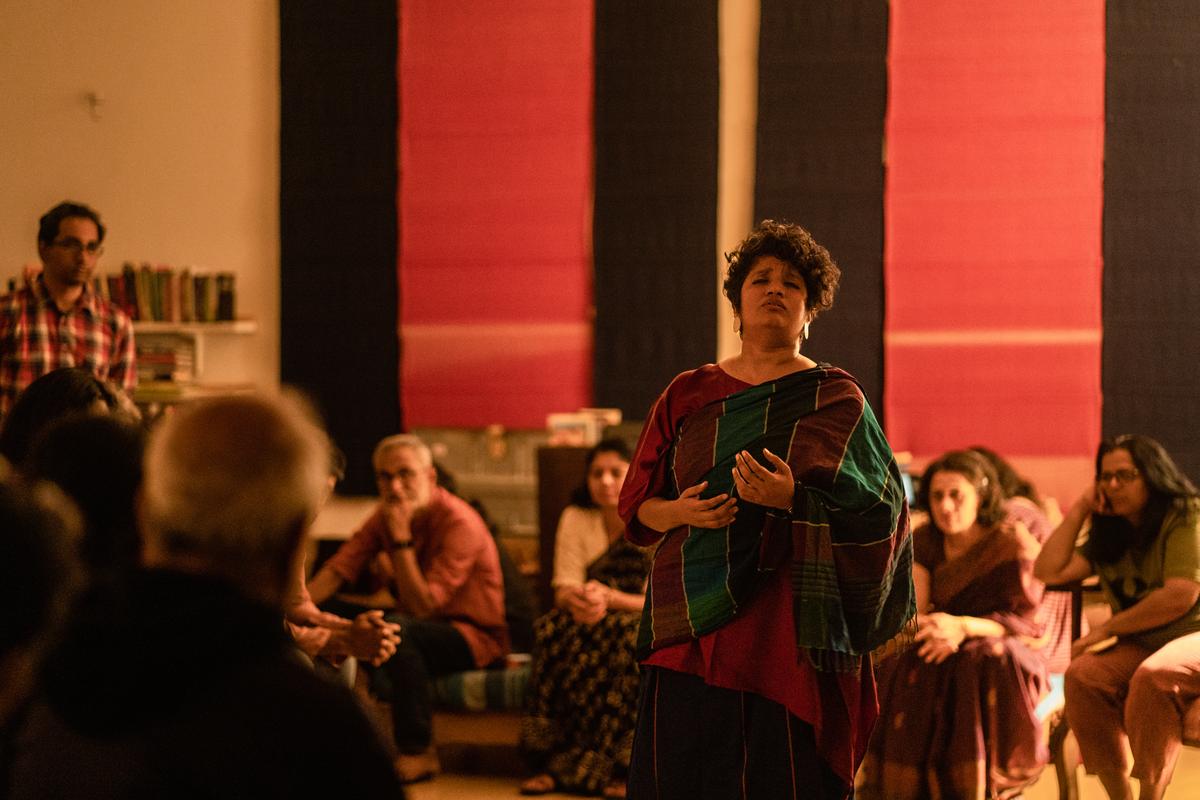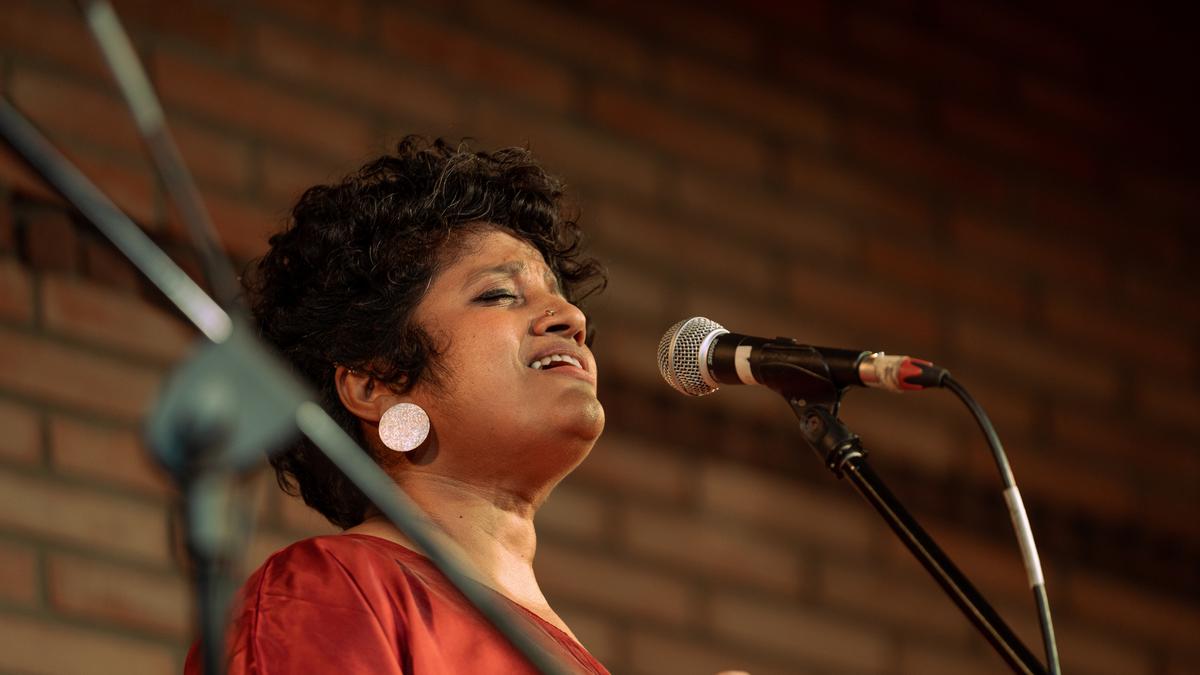Bindumalini in the show ‘Many Moons’ | Photo Credit: Sumukh Bharadwaj
‘Many Moons’ by Bindumalini explored the liminal spaces between sound and music, cognitive understanding and intuitive perception. The multi-layered musical experience presented at Courtyard Kuta, Bengaluru on its sixth anniversary invited the audience to slowly travel through shape-shifting soundscapes, rethinking assumptions about music creation. Beginning with a meditative immersion in a sound sculpture or music installation, the programme led the audience to a new space of listening and thinking about music in its second half, which was somewhat like a concert, but not quite.
From silences, sounds and musical question marks to lyric-less melodies, tunes and formal compositions, ‘Many Moons’ offered the audience a heart-to-heart conversation between different entities in music creation, without any dissonance. Does sound have to be arranged for music to emerge? How does the heart intuitively hear unity in harmony, the building blocks of which are actually notes of different registers? These were some of the questions that came up.
The first few presentations of the concert were happily unconstrained by words and held their foundation very lightly in ancient knowledge structures. Singers Bindumalini and Gurupriya Aatreya effectively used body rhythms and humming, serving the music with generous helpings of ta-ra-ra-ras and la-la-la-las, with lively strumming (sometimes singing, sometimes sound-making) by classical guitarist Abhaydev Praful. The composition ‘My Sweet Golden Moon’ paid homage to Ilayaraja’s ‘Yen Iniya Pon Nilave’, highlighting the intimate connection between music and memories. ‘Rain and Smoke’ was energetic and continued in the vocal-strings style. ‘Auto-Tune’, it turned out, was so titled because it was made in an auto – not because it was an elevated contemplation on the relationship between music and spontaneity.

Bindumalini, Gurupriya Atreya and Abhaydev Prafulla. Photo Courtesy: Sumukh Bhardwaj
These pieces could not be categorised, although they resonated with many musical genres, including jazz, classical music and film music. They demonstrated the scope of the human voice as a musical instrument, perhaps even an extension of the human mind when it does not feel trapped in its cerebral duties. The music was playful, often rejecting language and opening up avenues for the audience to make their own meaning of melody, rhythm and points that may or may not connect with them.
The next few pieces showed flashes of familiarity – one a song of lament, another a lullaby, and the third – a timeless classical composition, all based on the Carnatic raga Bhairavi. While the first two pieces were presented in fragments, the magnificent ‘Kamakshi’ was presented in its entirety as the grand finale. The piece came as a complete surprise, even provoking resistance in my mind, which had by then been prepared for the exploratory approach of the concert. Yet, how long can the heart or mind hold out against such a rich eulogy to the divine feminine like Bhairavi and ‘Kamakshi’? Also, till the end, the concert kept its promise of leaving loose ends open, which felt absolutely right.
Bindumalini marvels at the “magic hidden in plain sight”, talking about the “underlying unity of notes” called Natabhairavi in Carnatic music, Asavari in Hindustani music and the Natural Minor scale in Western music. After stumbling upon several cross-cultural approaches to this scale during research for another musical composition, she delved further into Natabhairavi’s branches and incarnations across the world to create ‘Many Moons’. She wanted the processes behind the show to be visible, so that the output would be a “warm welcome into a shared experience” rather than a “display” of the range and expressions of the raga.
This was the purpose behind sharing with the audience – playlists from the research phase and recordings of other musicians’ voices on their relationship with scale, played both outside the venue, before and after the show. The audience was also invited to absorb the “study material” that was created and then became the musical installation, which was a key part of the programme. She credits the Courtyard Koota team, led by Natasha Iype (the venue’s architect and artistic curator), for enabling such open-ended, experimental work; for showering “mad faith” on Priyanka Chandrasekar, Divya Sarangan, Sridhar Varadarajan and other team members who worked on the production, research, editing, sound and other aspects of the show.

‘Many Moons’ was a unique experience | Photo Credit: Sumukh Bharadwaj
Bindumalini effortlessly earns numerous awards at the national and international level, composes music for films, occasionally works as an actor in theatre and is deeply connected to many musical genres through performance, composition and research. She is constantly collaborating with composers and artists from diverse backgrounds because, she says, this opens up a “common space of shared creativity” that is much bigger than individual artists and their talents.
Talking about the title of the show, she shares a story from her school life. She and her friend happily went up to the roof to see the moon. They both did not have their glasses (which they needed) but they saw what they saw in the moon – everyone in their own way, even describing it to each other with great joy. Though there was only one moon in the sky, they enjoyed many moons simultaneously. Bindumalini says that this is the essence she tried to bring in ‘Many Moons’.
